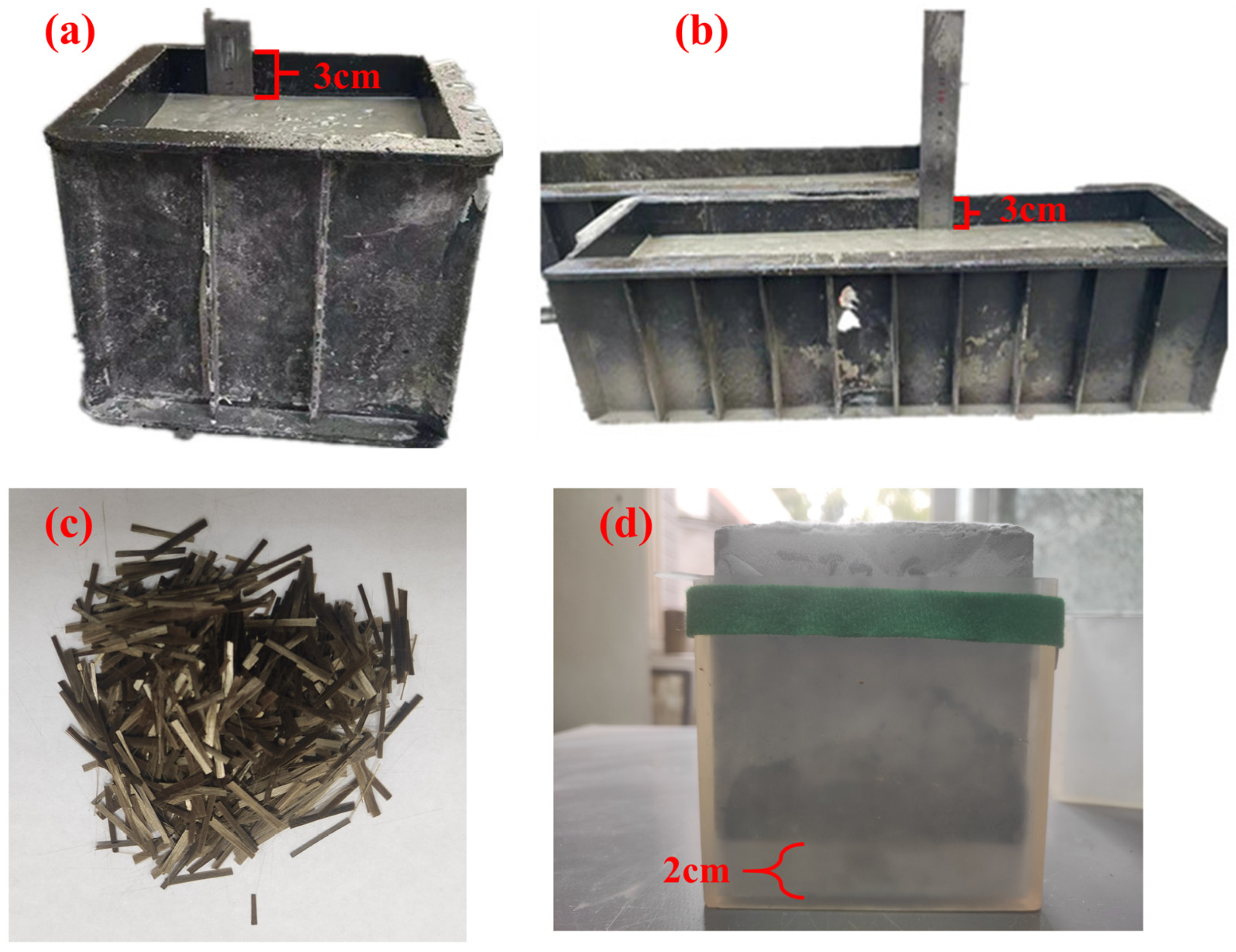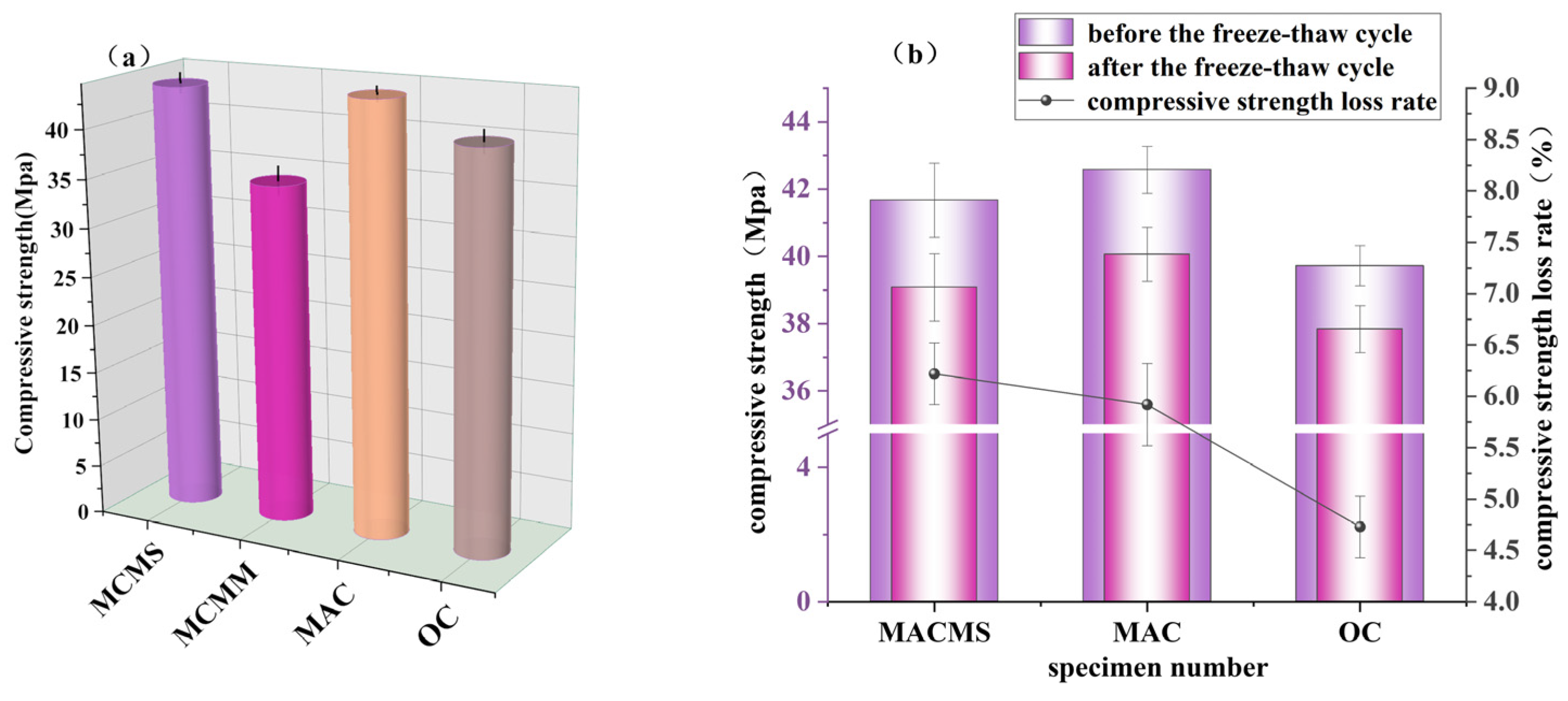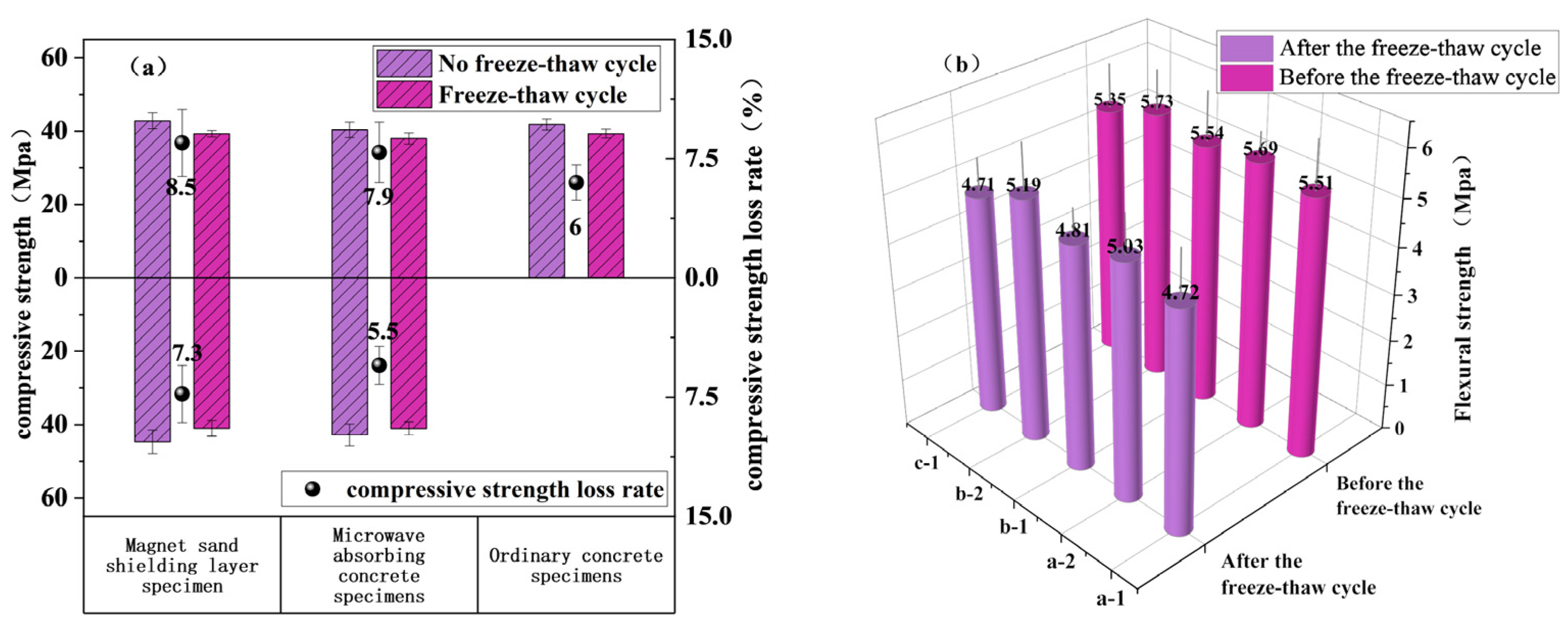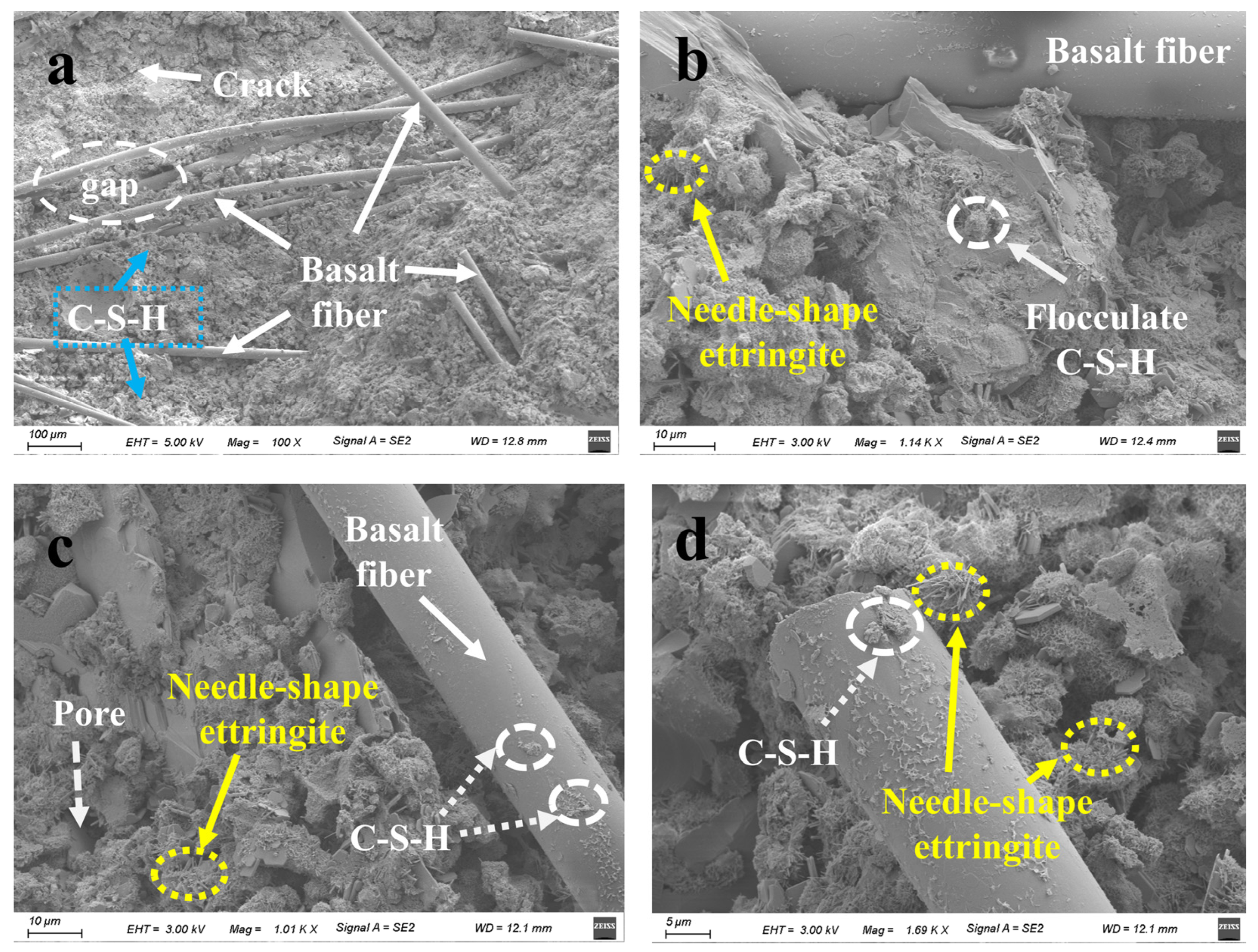Properties of Concrete Reinforced with a Basalt Fiber Microwave-Absorbing Shielding Layer
Abstract
:1. Introduction
2. Materials and Methods
2.1. Materials
2.1.1. Ordinary Materials
2.1.2. Shielding Layer Material
2.2. Specimen Preparation
2.2.1. OC and MAC Specimens
2.2.2. Cement Specimens with a Shielding Layer
2.2.3. Specimen Preparation with Basalt Fibers
2.2.4. Ice Layer Preparation
2.3. Methods
2.3.1. Heating Effect
2.3.2. De-Icing Effect
2.3.3. Mechanical Properties
2.3.4. Durability of Different Structures
2.3.5. SEM
3. Results and Discussion
3.1. Heating Effect
3.2. De-Icing Effect
3.2.1. Indoor De-Icing Test
3.2.2. Outdoor De-Icing Test
3.3. Mechanical Properties
3.3.1. Undoped Basalt Fiber
3.3.2. Incorporated Basalt Fiber
3.4. Durability of Different Structures
3.4.1. Wear Resistance
3.4.2. Freeze–Thaw Cycle
3.4.3. Water Absorption
3.5. SEM
4. Conclusions
- After incorporating a microwave shielding layer into microwave-absorbing cementitious concrete structures, the heating and temperature rise effects of MCMM and MCMS structures were improved by 27.1% and 17.2%, respectively, compared to those of the MAC structure. However, the compressive strength of MCMM and MCMS decreased by 14.1% and increased by 8%, respectively, compared to that of OC.
- MCMS exhibited a 14% improvement in indoor de-icing effectiveness compared to the MAC structure. In outdoor de-icing experiments, by comparing the rate of temperature rise before and after ice melting and the time required for the specimen surface to reach 0 °C, MCMS consistently demonstrated superior performance. Therefore, considering the comprehensive comparison, magnetite sand material was selected as the microwave shielding layer material for microwave de-icing of cementitious concrete pavement to improve de-icing efficiency.
- After incorporating basalt fibers into cementitious concrete specimens and subjecting them to freeze–thaw cycles, the compressive strength loss rate of MCMS decreased by 1.2%, and the flexural strength attenuation decreased by 2.7%. The strength loss rate of MAB decreased by 2.4%, and the flexural strength rate decreased by 3.8%. Moreover, the addition of basalt fibers also led to certain improvements in the durability performance of cementitious concrete specimens.
- The microstructure between basalt fibers and the cement matrix was observed and analyzed using SEM, providing microscopic evidence for the enhancement of mechanical strength and durability of cementitious concrete by incorporating basalt fibers. Therefore, a volume fraction of 0.2% of basalt fibers was selected to enhance the mechanical strength and durability of microwave-absorbing cementitious concrete pavement.
- In this study, MCMB and MAB specimens were formed at room temperature. Further research is needed to investigate the performance of specimens formed with the addition of basalt fibers under low-temperature conditions. Additionally, a comprehensive evaluation method and system for the performance of MAC pavement have not yet been established. Future studies could focus on scientifically and systematically researching microwave de-icing technology considering climate conditions and economic factors.
Author Contributions
Funding
Institutional Review Board Statement
Informed Consent Statement
Data Availability Statement
Conflicts of Interest
References
- Bardal, K.G.; Jørgensen, F. Valuing the risk and social costs of road traffic accidents—Seasonal variation and the significance of delay costs. Transp. Policy 2017, 57, 10–19. [Google Scholar] [CrossRef]
- Andleeb, Z.; Khawaja, H.; Moatamedi, M. Multiphysics based Analysis of Materials for Roads in Cold Regions to Prevent Ice Adhesion and Low-Temperature Crack Developments. Int. J. Multiphys. 2022, 16, 437–448. [Google Scholar]
- Peng, C.; Hu, Y.D.; You, Z.P.; Yang, H.; Nie, Y.T.; Wu, T.H.; Yang, H.N.; Ou, R.H. Preparation and anti-icing performance of acrylic superhydrophobic asphalt pavement coating with microwave heating function. Constr. Build. Mater. 2022, 344, 128289. [Google Scholar] [CrossRef]
- Theofilatos, A. Incorporating real-time traffic and weather data to explore road accident likelihood and severity in urban arterials. J. Saf. Res. 2017, 61, 9–21. [Google Scholar] [CrossRef]
- Deng, Y.; Wang, X.; Chen, L.; Liu, M.; Gao, M.; Zhao, J. A Study on the Heating and Deicing Performance of Microwave-Absorbing Asphalt Mixtures. Materials 2023, 16, 1051. [Google Scholar] [CrossRef]
- Zhou, J.; Lai, S.; Xu, X.; Chen, Y.; Chu, W.; Gao, Y. R&D of Equipment for Deicing by Thermal Water-jet and Mechanical Deicing Method. In Proceedings of the 2nd International Conference on Applied Mechanics, Materials and Manufacturing (ICAMMM 2012), Changsha, China, 17–18 November 2012; pp. 1288–1293. [Google Scholar]
- Gao, J.; Sha, A.; Wang, Z.; Tong, Z.; Liu, Z. Utilization of steel slag as aggregate in asphalt mixtures for microwave deicing. J. Clean. Prod. 2017, 152, 429–442. [Google Scholar] [CrossRef]
- Zhao, J.; Wang, X.; Xin, L.; Ren, J.; Cao, Y.; Tian, Y. Concrete pavement with microwave heating enhancement functional layer for efficient de-icing: Design and case study. Cold Reg. Sci. Technol. 2023, 210, 103846. [Google Scholar] [CrossRef]
- Micheli, D.; Pastore, R.; Vricella, A.; Morles, R.B.; Marchetti, M.; Delfini, A.; Moglie, F.; Primiani, V.M. Electromagnetic characterization and shielding effectiveness of concrete composite reinforced with carbon nanotubes in the mobile phones frequency band. Mater. Sci. Eng. B-Adv. Funct. Solid-State Mater. 2014, 188, 119–129. [Google Scholar] [CrossRef]
- Micheli, D.; Vricella, A.; Pastore, R.; Delfini, A.; Morles, R.B.; Marchetti, M.; Santoni, F.; Bastianelli, L.; Moglie, F.; Primiani, V.M.; et al. Electromagnetic properties of carbon nanotube reinforced concrete composites for frequency selective shielding structures. Constr. Build. Mater. 2017, 131, 267–277. [Google Scholar] [CrossRef]
- Wang, Z.; He, Z.; Wang, Z.; Ning, M. Utilization of magnetite as microwave absorber to prepare microwave-heatable aggregate for deicing in cementitious composite. Constr. Build. Mater. 2019, 227, 116664. [Google Scholar] [CrossRef]
- Wang, Z.; He, Z.; Wang, Z.; Ning, M. Microwave Deicing of Functional Pavement Using Sintered Magnetically Separated Fly Ash as Microwave-Heating Aggregate. J. Mater. Civ. Eng. 2019, 31, 04019127. [Google Scholar] [CrossRef]
- Liu, H.-I.; Shi, J.-J.; Qu, H.-Q.; Ding, D.-X. Feasibility of using recycled CRT funnel glass as partial replacement of high density magnetite sand in radiation shielding concrete. Trans. Nonferrous Met. Soc. China 2019, 29, 831–839. [Google Scholar] [CrossRef]
- Guo, H.; Wang, Z.; Huo, J.; Wang, X.; Liu, Z.; Li, G. Microwave heating improvement of asphalt mixtures through optimizing layer thickness of magnetite and limestone aggregates. J. Clean. Prod. 2020, 273, 123090. [Google Scholar] [CrossRef]
- Trigos, L.; Gallego, J.; Ignacio Escavy, J. Heating potential of aggregates in asphalt mixtures exposed to microwaves radiation. Constr. Build. Mater. 2020, 230, 117035. [Google Scholar] [CrossRef]
- Lu, S.; Bai, E.; Xu, J.; Chen, J. Research on electromagnetic properties and microwave deicing performance of carbon fiber modified concrete. Constr. Build. Mater. 2021, 286, 122868. [Google Scholar] [CrossRef]
- Liu, M.Y.; Wang, X.C.; Deng, Y.Y.; Guo, Y.C.; Zhao, J.; Li, M.X. Study on Microwave Deicing Efficiency of Microwave-Absorbing Concrete Pavements and Its Influencing Factors. Materials 2022, 15, 8923. [Google Scholar] [CrossRef]
- Guan, B.; Liu, J.; Zhao, H.; Wu, J.; Liu, J.; Yang, F. Investigation of the Microwave Absorption of Asphalt Mixtures Containing Magnetite Powder. Coatings 2019, 9, 813. [Google Scholar] [CrossRef]
- Wang, Z.; Bai, E.; Huang, H.; Wang, T.; Sun, H. Study on the electromagnetic property and microwave heating efficiency of concrete with magnetite aggregate. Constr. Build. Mater. 2022, 342, 128080. [Google Scholar] [CrossRef]
- Zhao, Y.; Liu, X.M.; Wei, D.M. Asphalt mixture with nucleus-shell structural microwave enhanced aggregate: Structure design, preparation and performance. Case Stud. Constr. Mater. 2023, 19, e02248. [Google Scholar] [CrossRef]
- Chung, S.-i.; Kim, P.K.; Ha, T.-g. High-performance transparent electromagnetic interference shielding film based on metal meshes. J. Micromech. Microeng. 2023, 33, 035002. [Google Scholar] [CrossRef]
- Li, Z.; Chen, F.; Ren, J.; Chen, Z. Experimental Study on the Impermeability and Micromechanisms of Basalt Fiber-Reinforced Soil-Cement in Marine Environments. Coatings 2023, 13, 532. [Google Scholar] [CrossRef]
- Wang, Z.H.; Bai, E.; Ren, B.; Liu, C.J.; Liu, J.L.; Huang, H. Microwave heating efficiency and frost resistance of concrete modified with powder absorbing materials. Constr. Build. Mater. 2023, 379, 131145. [Google Scholar] [CrossRef]
- Fu, C.; Liu, K.; Liu, Q.; Xu, P.; Dai, D.; Tong, J. Exploring directional energy conversion behavior of electromagnetic-based multifunctional asphalt pavement. Energy 2023, 268, 126573. [Google Scholar] [CrossRef]
- JTG D40-2011; Ministry of Communications of the People’s Republic of China Specifications for Design of Highway Cement Concrete Pavement. Ministry of Communications: Beijing, China, 2011.
- JTG 3420-2020; Ministry of Communications of the People’s Republic of China Testing Methods of Cement and Concrete for Highway Engineering. Ministry of Communications: Beijing, China, 2020.
- Merizgui, T.; Hadjadj, A.; Kious, M.; Gaoui, B. Impact of Temperature Variation on the Electromagnetic Shielding Behavior of Multilayer Shield for EMC Applications. Rev. Compos. Mater. Av.-J. Compos. Adv. Mater. 2019, 29, 363–367. [Google Scholar] [CrossRef]
- Qiu, H.; Chen, H.; Wu, Y.; Wu, J.; Liu, Y.; Lin, Y. Heating Characteristics and Deicing Properties of Magnetite Mortar Microwave-Absorbing Layer on Concrete Pavement. J. Mater. Civ. Eng. 2023, 35, 15729. [Google Scholar] [CrossRef]
- Chen, Q.; Wang, C.H.; Li, Y.W.; Feng, L.; Huang, S. Performance Development of Polyurethane Elastomer Composites in Different Construction and Curing Environments. Constr. Build. Mater. 2023, 365, 130047. [Google Scholar] [CrossRef]
- Afroz, M.; Patnaikuni, I.; Venkatesan, S. Chemical durability and performance of modified basalt fiber in concrete medium. Constr. Build. Mater. 2017, 154, 191–203. [Google Scholar] [CrossRef]
- Shu, Y.; Zhang, J. Effect of Basalt Fiber Content and Length on the Strength and Crack Development of Polyvinyl Alcohol/Basalt Hybrid Fiber-Reinforced Cement Soil. Polymers 2023, 15, 2146. [Google Scholar] [CrossRef]
- Ngoc, L.N.; Van, H.L. Mechanical and Shrinkage Behavior of Basalt Fiber Reinforced Ultra-High-Performance Concrete. Int. J. Geomate 2021, 20, 28–35. [Google Scholar]
- Ogut, R.; Demir, A. The Effect of the Basalt Fiber on Mechanical Properties and Corrosion Durability in Concrete. Arab. J. Sci. Eng. 2023, 48, 5097–5114. [Google Scholar] [CrossRef]
- Shagnay, S.; Velasco, F.; del Campo, A.; Torres-Carrasco, M. Wear behavior in pastes of alkali-activated materials: Influence of precursor and alkali solution. Tribol. Int. 2020, 147, 106293. [Google Scholar] [CrossRef]
- Ahmed, N.Y.; Alkhafaji, F.F. Enhancements and mechanisms of nano alumina (Al2O3) on wear resistance and microstructure characteristics of concrete pavement. IOP Conf. Ser. Mater. Sci. Eng. 2020, 871, 012001. [Google Scholar] [CrossRef]
- Li, Z.; Shen, A.; Zeng, G.; Chen, Z.; Guo, Y. Research progress on properties of basalt fiber-reinforced cement concrete. Mater. Today Commun. 2022, 33, 104824. [Google Scholar] [CrossRef]
- Cui, G.; Zhou, C.; Liu, Z. Prediction Method of Water Absorption of Soft Rock Considering the Influence of Composition, Porosity, and Solute Quantitatively. Appl. Sci. 2022, 12, 104824. [Google Scholar] [CrossRef]
- Zhang, C.; Zhang, S.; Yu, J.; Kong, X. Water absorption behavior of hydrophobized concrete using silane emulsion as admixture. Cem. Concr. Res. 2022, 154, 106738. [Google Scholar] [CrossRef]
- Xu, X.; Cui, S.; Xu, L.; Zeng, G.; Wang, X. Effect of different fiber sizing on basalt fiber-reinforced cement-based materials at low temperature: From macro mechanical properties to microscopic mechanism. Constr. Build. Mater. 2023, 392, 131773. [Google Scholar] [CrossRef]








| Model | Density (g/cm3) | Specific Surface Area (m2/kg) | Setting Time (min) | Compressive Strength (MPa) | Flexural Strength (MPa) | |||
|---|---|---|---|---|---|---|---|---|
| Initial Setting | Final Setting | 3 d | 28 d | 3 d | 28 d | |||
| P.C.32.5 | 3.15 | 359 | 128 | 279 | 12.4 | 37.9 | 3.1 | 6.8 |
| Apparent Density (g/cm3) | Crushing Value | Needle Flake Content (%) | Water Absorption (%) | Mud Content (%) | Firmness (%) |
|---|---|---|---|---|---|
| 2.64 | 17 | 6 | 1.0 | 0.8 | 6 |
| Apparent Density (g/cm3) | Bulk Content (%) | Mud Content (%) | Iron Content (%) | Mohs Hardness |
|---|---|---|---|---|
| 3.78 | 2.77 | 0.2 | 65~85 | 6 |
| Length (mm) | Single Fiber Diameter (μm) | Density (g/cm3) | Tolerance to Maximum Temperature (°C) | Elastic Modulus (G Pa) | Tensile Strength (MPa) |
|---|---|---|---|---|---|
| 12 | 14 | 2.73 | 625 | 95~105.4 | 3250~3800 |
| Needle Flake Particle Content (%) | Crushing Value Index | Alkali Activity (%) |
|---|---|---|
| 2 | 19.5 | 0.06 |
| Specimen Types | Cement (kg) | Water (kg) | Sand (kg) | Coarse Aggregate (kg) | Magnetite (16–19 mm) (kg) | Water-Reducing Agent (kg) | |||
|---|---|---|---|---|---|---|---|---|---|
| 4.75–9.5 (mm) | 9.5–16.0 (mm) | 16.0–19.0 (mm) | 19.0–26.5 (mm) | ||||||
| OC | 375 | 3.75 | 739 | 255 | 255 | 370 | 277 | — | 3.75 |
| MAC | 375 | 3.75 | 739 | 255 | 255 | — | 277 | 530 | 3.75 |
| Cement (kg) | Sand (kg) | Coarse Aggregate (kg) | Hematite (kg) | Magnetite Sand (kg) | Water Reducing Agent (kg) | |||
|---|---|---|---|---|---|---|---|---|
| 4.75–9.5 (mm) | 9.5–16 (mm) | 19–26.5 (mm) | 9.5–16 (mm) | 16–19 (mm) | ||||
| 375 | 622 | 255 | 182 | 197 | 141 | 715 | 644 | 3.75 |
Disclaimer/Publisher’s Note: The statements, opinions and data contained in all publications are solely those of the individual author(s) and contributor(s) and not of MDPI and/or the editor(s). MDPI and/or the editor(s) disclaim responsibility for any injury to people or property resulting from any ideas, methods, instructions or products referred to in the content. |
© 2023 by the authors. Licensee MDPI, Basel, Switzerland. This article is an open access article distributed under the terms and conditions of the Creative Commons Attribution (CC BY) license (https://creativecommons.org/licenses/by/4.0/).
Share and Cite
Jiang, A.; Song, Z.; Wang, X.; Zhao, J.; Ren, J. Properties of Concrete Reinforced with a Basalt Fiber Microwave-Absorbing Shielding Layer. Sustainability 2023, 15, 15919. https://doi.org/10.3390/su152215919
Jiang A, Song Z, Wang X, Zhao J, Ren J. Properties of Concrete Reinforced with a Basalt Fiber Microwave-Absorbing Shielding Layer. Sustainability. 2023; 15(22):15919. https://doi.org/10.3390/su152215919
Chicago/Turabian StyleJiang, Aqing, Zihao Song, Xuancang Wang, Jing Zhao, and Junru Ren. 2023. "Properties of Concrete Reinforced with a Basalt Fiber Microwave-Absorbing Shielding Layer" Sustainability 15, no. 22: 15919. https://doi.org/10.3390/su152215919
APA StyleJiang, A., Song, Z., Wang, X., Zhao, J., & Ren, J. (2023). Properties of Concrete Reinforced with a Basalt Fiber Microwave-Absorbing Shielding Layer. Sustainability, 15(22), 15919. https://doi.org/10.3390/su152215919






